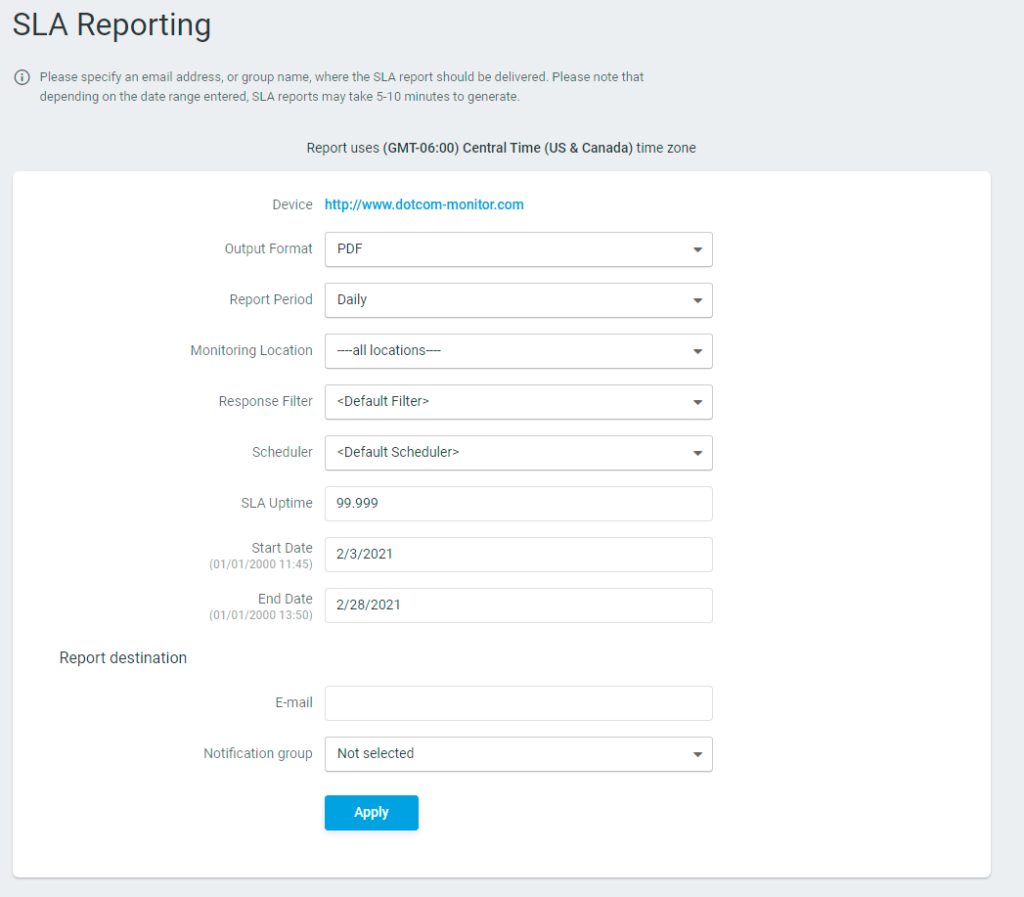The Service Level Agreement (SLA) report is an on-demand report where you can review the SLA status of a single device over a period that you specify.
-
What is an SLA?
SLA Monitoring with the Dotcom-Monitor Platform
Dotcom-Monitor is set up to monitor and report on the commitments service providers make to customers in SLA agreements. Utilizing SLA monitoring from Dotcom-Monitor allows you entrust in a neutral third-party that your service provider is adhering to their commitments.
SLAs must contain several provisions, including:
- An agreed upon level of service
- Options for support and remediation
- Provisions that outline enforcement when service levels are not met
- A guaranteed level of system performance as it relates to downtime or uptime
- A specified level of customer support
- Specifications regarding what software or hardware will be provided and for what fee
Within the Dotcom-Monitor solution, the SLA report is a special reporting group that provides you with a single view of SLA performance over specified time intervals.
As a Dotcom-Monitor customer, you can define your SLA provisions with your service provider from within the Dotcom-Monitor solution. For example, you can specify that uptime for your website from Monday through Friday between 9 a.m. and 5 p.m. is expected to be 99.98 percent. Next, you can specify website uptime during non-business hours. For example, you can set uptime between 5 p.m. and 9 a.m. to be 99.8 percent during the weekdays and that uptime during the weekends should be 99.5 percent. After setting the above parameters into the SLA reporting tool, the Dotcom-Monitor platform will create summary monitoring reports (daily, weekly, monthly, quarterly) showing when, or if, uptime is or is not, met. These SLA reports can be used and shared with both the customer and the service provider, ensuring all parties are made aware of any changes.
For customers, SLA reporting creates benefits by providing the following benefits:
- Determining if a service provider is continuing to meet service level expectations.
- Providing real availability statistics to compare with the SLA.
- Providing any specific days and times when the SLA is not met by the service provider helping to pinpoint performance issues
- Documenting when the SLA is not met in order to ensure refunds, or credits, are distributed appropriately to customers based on the SLA contract.
For service providers, SLA reports create benefits by providing the following benefits:
- Showing your customers that you are continually reviewing and monitoring their website uptime.
- Service providers can provide SLA reports to customers to show that a third-party solution such as Dotcom-Monitor, is determining if uptime is met, or when an SLA is frequently exceeded.
- Having a Documentation process in place proves actual uptime and helps to address disputes arising around the SLA, avoiding unnecessary chargebacks.
- Quickly identify the responsible parties if an SLA falls below an acceptable or pre-defined threshold.
If you have an SLA with your hosting service provider, you can count on the website monitoring and network monitoring services from Dotcom-Monitor to provide you with the ability to monitor and enforce continuous SLA compliance.
How to Create an SLA Report
The SLA report can be created on-demand to assist in SLA management and to track service level requirements as set by the service provider. SLA reports can be configured to meet your specific needs and business requirements.
You can configure an SLA Report for a monitoring device under Reports > SLA Reporting or by selecting SLA from a device action menu. From this screen, you can further customize the report by configuring the SLA report settings. For example, you can set the output of the report (CSV or PDF), reporting periods (daily, weekly, monthly, or quarterly), and select from all monitoring locations or just a few specific locations, depending on your requirements.

Additionally on this page, you also have the option to set response filters that filter out and ignore any error conditions you do not want to appear on the SLA report. For example, you can set up a filter that only reports an error if more than three monitoring locations report the same error. Next, you can set the scheduler to include the day/time periods to include, or exclude, monitoring services. Just note that the schedule must be set prior to creating the SLA report.
Lastly, you can specify the SLA uptime percentage, start date and end date, and the appropriate email address or notification group (if appropriate) that the report can be sent to. Once the report is ready, you can review the uptime chart and SLA table to ensure the specified target SLA goal has been met or if any failures occurred over the course of the monitoring period. Any length of time where the uptime percentage was not met will show up highlighted in red on the report. Any periods where monitoring was postponed will show up as yellow on the report. There may be occasions throughout the year where you may want to indicate when you want to postpone monitoring during routine maintenance so that your reports do not include unnecessary false alerts.
The SLA report below shows SLA uptime metrics for various performance counter monitoring devices.

For more information about building your SLA Report, read our article about configuring an SLA Report and watch this short video on how to quickly and easily create an SLA Report.
